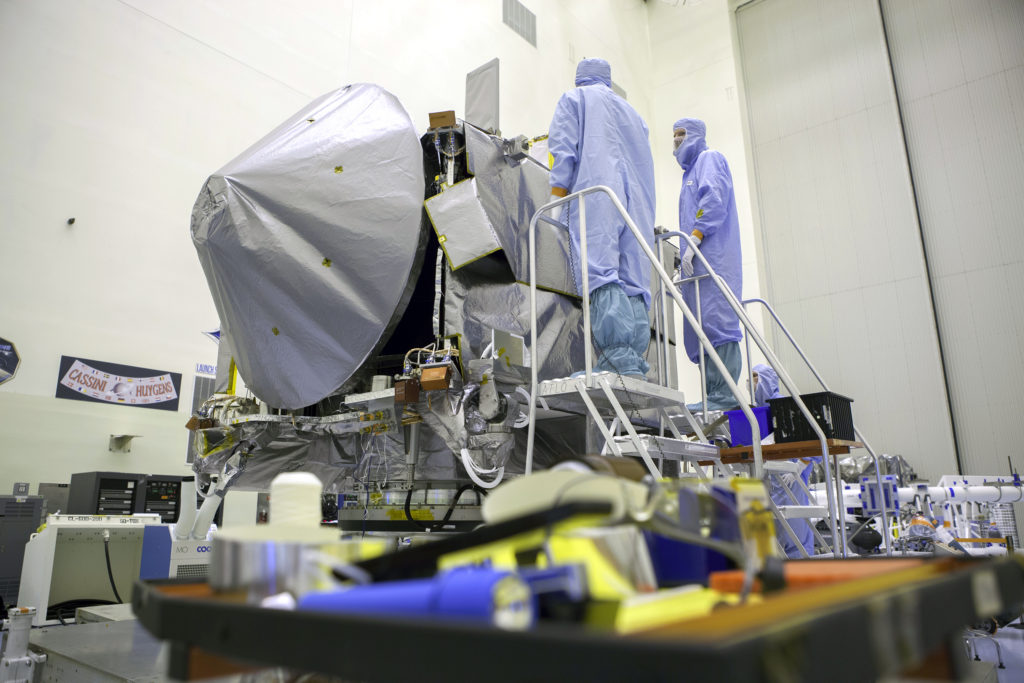On approach to perijove | Image: NASA / JPL / SwRI / MSSS / Ted Stryk
Perijove 1/36
Juno, NASA’s Jupiter-orbiting spacecraft, has just completed its first “perijove,” or up-close-and-personal flyby of the giant radioactive ball of gas. When they launched the spacecraft, the idea was that it would reach Jupiter on July 4, fire its engines, and go into a 107-day orbit, so its first close pass would have been October 19, at which point it would have fired its thrusters again to move into its eventual 14-day orbit. Instead, the team decided to split that into two 53.5-day orbits, to give them more than two weeks to come up with solutions if the first perijove went pear-shaped. Well, the first pass looks to have gone beautifully, and is apparently giving NASA scientists a great preview of things to come. So far we’ve only had reports of interesting data coming down, and it’ll probably be a few days before the best photos hit the downlink (Jupiter is, after all, a long way away), but we do have one photo from about two hours out from perijove, and if it’s anything to go by, the better quality ones are going to be something else indeed. Juno will return to Jupiter as planned on October 19, when it’ll fire its thrusters and go into an orbit where it gets beat up by getting so close to Jupiter once every two weeks. I think there are 36 planned perijoves, so here’s the the first of many. You can read more at Spaceflight Now and at The Planetary Society.
Dragon Returns

This week another SpaceX cargo Dragon capsule returned safely to Earth, carrying 3000 pounds of completed experiments and equipment from the International Space Station. The capsule was released from the ISS just after 6am ET on August 26th, and splashed down off the coast of Baja California roughly 6 hours later. It was quickly recovered and taken to NASA to offload before the used capsule headed off to SpaceX’s test facility in McGregor, Texas for a post-flight analysis. Among the returned experiments were the results of an experiments on heart cells, tomato seeds, liquid crystals, and the human immune system. The Dragon is currently the only way NASA can return significant weight to Earth, so kudos to SpaceX for enabling experimental return that simply couldn’t take place otherwise. You can read more about the returned payload at NASA’s ISS blog.
OSIRIS-REx Countdown!

NASA’s asteroid sample-return mission OSIRIS-REx is really getting down to the final days now. Tomorrow, August 29, technicians will take the $800 million probe and, safely ensconced in its fairing, attach it to the top of an Atlas V rocket at the Vertical Integration Facility at Cape Canaveral. If all goes to plan, the probe will launch within a two-hour window that starts just after 7am (eastern daylight) on Thursday, September 8. From there it’ll head on a long trip to the asteroid Bennu, passing by the Earth in late 2017 to get a gravitational assist so as to get to Bennu by August 2018. OSIRIS-REx will spend over a year there, charting the surface and taking readings of the whole asteroid, before trying to collect a sample and return it to Earth around September 2023. If all goes well, at the end of the seven-year mission we’ll have a lot better understanding of another of our stellar neighbours, as well as actual samples of an actual asteroid that haven’t been subjected to the heat of re-entry. It’s the largest sample return since the Apollo missions. You can get relatively up-to-date information on the mission’s progress at NASA’s OSIRIS-REx mission blog, and there’s a fantastic animated rundown on all the details of the mission over at asteroidmission.org/mission.
ICYMI
In case you missed anything we got up to this week, check it out now by clicking on the links below:
- On Monday, I posted about a certain “chupacabra” video making the rounds
- On Tuesday, I complained about the possibility of a time when USB-C is the only headphone jack on phones
- On Wenesday, I put on my curmudgeon cap and posted about the inveitability of linguistic change
- On Thursday, I posted about the detection of a planet around Promixa Centauri (!!), and
- On Friday, Elle posted about the “Burkini” and the reaction to it
Read and share!
Best of the Rest
As usual, there’s more than we can get to in any one week, so here’s your weekly linkspam — enjoy!
- Tesla’s new battery pack boosts range to 300+ miles and drops the 0-60 to a “supercar”-worthy 2.5 seconds
- Someone’s making vegan milk (actual milk) using bacteria instead of cows
- Linux turned 25 years old
- Google Fiber took a blow as Alphabet explores wireless internet provision technologies
- Scientists are developing plasma technology to make planes fly better, faster, and more efficiently (and glow!)
- Researchers announced they’d created the first soft-bodied robot, the “octobot”, and
- China has released plans for a Mars rover, to join the growing rover army on Mars
***
That’s all for today. Thanks for reading! Except for the very *very* occasional tip (we take Venmo now!), I only get paid in my own (and your) enthusiasm, so please like This Week In Tomorrow on Facebook, follow me on Twitter @TWITomorrow, and tell your friends about the site!
If you like our posts and want to support our site, please share it with others, on Facebook, Twitter, Reddit — anywhere you think people might want to read what we’ve written. Thanks so much for reading, and have a great week.
***
Richard Ford Burley is a human, writer, and doctoral candidate at Boston College, as well as an editor at Ledger, the first academic journal devoted to Bitcoin and other cryptocurrencies. In his spare time he writes about science, skepticism, feminism, and futurism here at This Week In Tomorrow.

